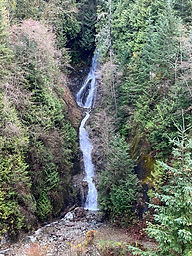Stinky Bugs, Crummy Crabs and Sketchy Squirrels
- kc dyer

- Nov 4
- 2 min read
It's not just unwelcome plants moving into town

Invasive species come in all shapes and sizes, and not all of them have roots.
In addition to unwelcome plants that have moved into the region and taken over native habitats, a few invasive animal species have ecologists concerned.
According to the Sea to Sky Invasive Species Council (SSISC), invasive animal species that already have a presence in this region include goldfish and red-eared slider turtles. Insects that have been spotted in the Sea to Sky include the brown marmorated stink bug and the spongy moth.
The SSISC is particularly concerned about the unwelcome arrival of the. European Green Crab. This animal is native to Europe and North Africa, but has established itself along the west coast of North America, and has been spotted on Salt Spring Island, near the entrance to Átl'ḵa7tsem / Howe Sound.
According to the SSISC, "this aggressive invasive crab competes with native species for prey and has the potential to upset the overall balance of our local marine ecosystem. It is also known to disrupt eelgrass beds, which are important habitat for young salmon."
The organization began monitoring for these invasive crabs in 2021. The crabs continue to infiltrate coastal areas (as can be seen in an animation found on the Pacific Salmon Foundation's website HERE), but have not yet been identified in Howe Sound waters.
Last year, brown marmorated stink bugs were spotted in Squamish, according to Claude-Anne Godbout-Gauthier of the SSISC. Native to Asia, these were first detected in BC in 2015, and are now established in the Metro Vancouver and Fraser Valley regions, as well as on Vancouver Island and around Kelowna.
These stink bugs are considered a nuisance to homeowners because they aggregate in and around buildings in the fall in search of a warm spot to overwinter, and emit a foul odour when crushed.
While they don’t bite people or animals, nor damage buildings, Godbout-Gautier's main concern is that they feed on fruit and vegetables, leaving puncture marks that damage the crops. She adds that their presence on grapes can also taint wine.
The Invasive Species Council of BC (ISC) also cites the Eastern grey squirrel as one of six invasive mammal species in the province.
"Eastern grey squirrels dig up lawns and gardens, chew through electrical wires, eaves and shingles, and nest in roofs, attics, and chimneys. They compete with native squirrel species and birds for habitat, and feed on bird eggs and nestlings."
To learn more about the organizations monitoring invasive species in British Columbia, check out the SSISC HERE, and the ISC HERE.

The Watershed values your opinion. Leave your comment below or
Email us at editor@lionsbaywatershed.ca.
Like what you're reading? Please support local independent journalism
by subscribing to The Watershed HERE.








Comments